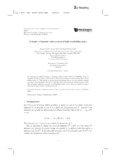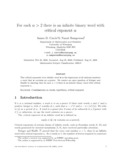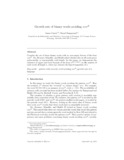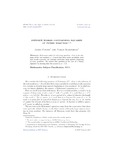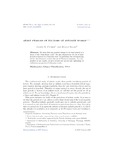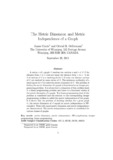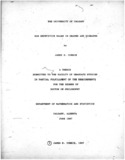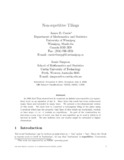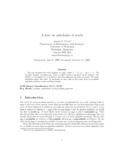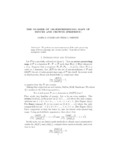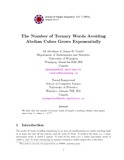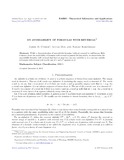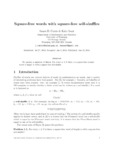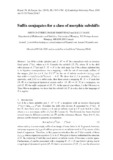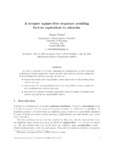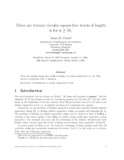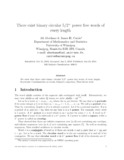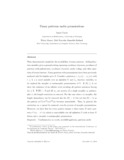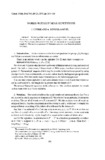Browsing James D. Currie by Title
Now showing items 21-39 of 39
-
A family of formulas with reversal of high avoidability index
(World Scientific, 2017)We present an infinite family of formulas with reversal whose avoidability index is bounded between 4 and 5, and we show that several members of the family have avoidability index 5. This family is particularly interesting ... -
For each a > 2 there is an Infinite Binary Word with Critical Exponent a
(The Electronic Journal of Combinatorics, 2008-08-31)The critical exponent of an infinite word w is the supremum of all rational numbers α such that w contains an α-power. We resolve an open question of Krieger and Shallit by showing that for each α>2 there is an infinite ... -
Growth rate of binary words avoiding xxxR
(Elsevier, 2016-01)Abstract Consider the set of those binary words with no non-empty factors of the form xxx^R. Du, Mousavi, Schaeffer, and Shallit asked whether this set of words grows polynomially or exponentially with length. In this ... -
Infinite words containing squares at every position
(EDP Sciences, 2010)Richomme asked the following question: what is the infimum of the real numbers α > 2 such that there exists an infinite word that avoids α-powers but contains arbitrarily large squares beginning at every position? We resolve ... -
Least Periods of Factors of Infinite Words
(EDP Sciences, 2009)We show that any positive integer is the least period of a factor of the Thue-Morse word. We also characterize the set of least periods of factors of a Sturmian word. In particular, the corresponding set for the Fibonacci ... -
The metric dimension and metric independence of a graph
(The Charles Babbage Research Centre, 2001)A vertex x of a graph G resolves two vertices u and v of G if the distance from x to u does not equal the distance from x to v. A set S of vertices of G is a resolving set for G if every two distinct vertices of G are ... -
Non repetitive walks in graphs and digraphs
(The University of CalgaryUniversity of Calgary, 1987-06)A word $w$ over alphabet $\Sigma$ is {\em non-repetitive} if we cannot write $w=abbc$, $a,b,c\in\Sigma^*$, $b\ne\epsilon$. That is, no subword of $w$ appears twice in a row in $w$. In 1906, Axel Thue, the Norwegian number ... -
Non-Repetitive Tilings
(The Electronic Journal of Combinatorics, 2002-07-03)In 1906 Axel Thue showed how to construct an infinite non-repetitive (or square-free) word on an alphabet of size 3. Since then this result has been rediscovered many times and extended in many ways. We present a two-dimensional ... -
A Note on Antichains of Words
(The Electronic Journal of Combinatorics, 1995-10-14)We can compress the word 'banana' as xyyz, where x= 'b', y= 'an',z= 'a'. We say that 'banana' encounters yy. Thus a 'coded' version of yy shows up in 'banana'. The relation 'u encounters w' is transitive, and thus generates ... -
The number of order–preserving maps of fences and crowns
(Springer, 1991-06)We perform an exact enumeration of the order-preserving maps of fences (zig-zags) and crowns (cycles). From this we derive asymptotic results. -
The Number of Ternary Words Avoiding Abelian Cubes Grows Exponentially
(2004-06-19)We show that the number of ternary words of length n avoiding abelian cubes grows faster than r^n, where r = 2^{1/24} -
On avoidability of formulas with reversal
(EDP Sciences, 2018-02-13)While a characterization of unavoidable formulas (without reversal) is well-known, little is known about the avoidability of formulas with reversal in general. In this article, we characterize the unavoidable formulas ... -
Square-free Words with Square-free Self-shuffles
(The Electronic Journal of Combinatorics, 2014-01-12)We answer a question of Harju: For every n ≥ 3 there is a square-free ternary word of length n with a square-free self-shuffle. -
Suffix conjugates for a class of morphic subshifts
(Cambridge University Press, 2015-09)Let A be a finite alphabet and f: A^* --> A^* be a morphism with an iterative fixed point f^\omega(\alpha), where \alpha{} is in A. Consider the subshift (X, T), where X is the shift orbit closure of f^\omega(\alpha) and ... -
A Ternary Square-free Sequence Avoiding Factors Equivalent to abcacba
(The Electronic Journal of Combinatorics, 2016-05-27)We solve a problem of Petrova, finalizing the classification of letter patterns avoidable by ternary square-free words; we show that there is a ternary square-free word avoiding letter pattern xyzxzyx. In fact, we characterize ... -
There are Ternary Circular Square-Free Words of Length n for n ≥ 18
(The Electronic Journal of Combinatorics, 2002-10-11)There are circular square-free words of length n on three symbols for n≥18. This proves a conjecture of R. J. Simpson. -
There Exist Binary Circular 5/2+ Power Free Words of Every Length
(The Electronic Journal of Combinatorics, 2004-01-23)We show that there exist binary circular 5/2+ power free words of every length. -
Unary patterns under permutations
(Elsevier, 2018-06-04)Thue characterized completely the avoidability of unary patterns. Adding function variables gives a general setting capturing avoidance of powers, avoidance of patterns with palindromes, avoidance of powers under coding, ... -
Words without Near-Repetitions
(Canadian Mathematical Society, 1992-06-01)We find an infinite word w on four symbols with the following property: Two occurrences of any block in w must be separated by more than the length of the block. That is, in any subword of w of the form xyx, the length of ...

